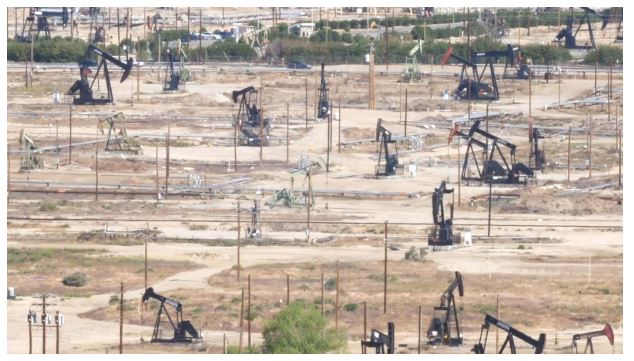Pumpjacks in Bakersfield, California, located about 100 miles from Sequoia and Kings Canyon National Parks. The development in this region contributes significantly to unhealthy park air
© Matt Abele/NPCA
Cesar E. Chavez National Monument, Sequoia and Kings Canyon National Parks and Santa Monica Mountains National Recreation Area are among the public lands that could see oil and gas development nearby if the BLM’s plan advances.
 more than 1.2 million acres to oil and gas leasing. The National Parks Conservation Association, (NPCA) Central Valley Air Quality Coalition and Cesar Chavez Foundation are among the organizations denouncing the Bureau of Land Management’s (BLM) final Supplemental Environmental Impact Statement for future fracking in the area.
more than 1.2 million acres to oil and gas leasing. The National Parks Conservation Association, (NPCA) Central Valley Air Quality Coalition and Cesar Chavez Foundation are among the organizations denouncing the Bureau of Land Management’s (BLM) final Supplemental Environmental Impact Statement for future fracking in the area.Cesar E. Chavez National Monument, Sequoia and Kings Canyon National Parks and Santa Monica Mountains National Recreation Area are among the public lands that could see oil and gas development nearby if the BLM’s plan advances. Such energy development could also result in cumulative air and climate impacts, harming neighboring communities already suffering from air pollution.
“The narrative around Sequoia National Park is increasingly shifting from towering trees to forests of oil rigs, as the BLM gambles with the health of parks and surrounding communities,” said Mark Rose, Sierra Nevada Program Manager for NPCA. “Sequoia and Kings Canyon National Parks are two of the most polluted parks in the nation in terms of air quality, and this plan exacerbates those impacts. Even worse, the BLM refused to undertake even the most basic analysis of impacts with its plan.”
Spoiled Parks, a new report released by NPCA, identified Sequoia National Park as among the 12 most threatened in America from oil and gas development. The Trump administration’s aggressive energy policies are threatening to irreparably harm some of our country’s most cherished national parks.
“The San Joaquin Valley is one of the most polluted air basins in the United States, and Kern County arguably the most polluted county in the nation,” said Genevieve Gale, Executive Director of the Central Valley Air Quality Coalition. “As a result, Valley residents are more susceptible to asthma attacks, heart attacks, stroke, premature death, and the development of chronic heart and lung diseases. Additional pollution from expanded oil and gas operations will add insult to injury, adding toxic, smog-forming and particulate pollution to an already overburdened air basin.“
“We are opposed to the current administration’s amendment to a Land Management Plan which will now allow fracking near the Cesar Chavez National Monument,” said Paul S. Park, Senior Counsel at the Cesar Chavez Foundation. “Studies have shown that this can have a negative environmental impact and an increase in seismic activity to an historic area that has been designated a national landmark by the federal government.”
About National Parks Conservation Association: For 100 years, the nonpartisan National Parks Conservation Association has been the leading voice in safeguarding our national parks. NPCA and its more than 1.3 million members and supporters work together to protect and preserve our nation’s most iconic and inspirational places for future generations. For more information, visit www.npca.org/100.
Source: NPCA
BLM Bakersfield Announces Availability of Hydraulic Fracturing Impacts Analysis
November 1, 2019 - BAKERSFIELD, Calif. – The Bureau of Land Management (BLM) has released the Bakersfield Field Office Final Supplemental Environmental Impact Statement (EIS) analyzing the potential effects of hydraulic fracturing associated with oil and gas development on new leases on public lands and Federal minerals. This planning effort supports the decisions within the 2014 Bakersfield Field Office Resource Management Plan (RMP) and does not make any new public lands or Federal minerals available to oil and gas development.
This effort supports the Administration’s priority of promoting environmentally responsible energy development, while creating jobs and providing economic opportunities for local communities guided by Executive Order 13783: Promoting Energy Independence and Economic Growth and Secretarial Order 3349: American Energy Independence.
The Bakersfield Field Office planning area includes eastern Fresno, western Kern, Kings, Madera, San Luis Obispo, Santa Barbara, Tulare and Ventura counties.
The 2014 Bakersfield RMP and Record of Decision determined areas available for oil and gas development on approximately 1.2 million acres of Federal minerals, which includes roughly 400,000 surface acres of BLM-managed public land. Approximately one million acres are available to oil and gas leasing with stipulations that would be applied to protect resources. No new stipulations have been identified. No new leases are issued, and no permits to drill are approved with the finalization of this analysis. If proposed, new leases and/or requests for permits to drill and their potential impacts would be addressed at the site or project-specific level in a subsequent tiered environmental analysis.
The Final Supplemental EIS analyzes air and atmospheric values, water quality and quantity, cultural resources and Native American values, livestock grazing, biological resources, mineral resources, seismicity, visual resources, and social and economic resources.
The BLM incorporated into the Final Supplemental EIS the results of independent, comprehensive, peer-reviewed studies done by the California Council on Science and Technology and Lawrence Berkeley National Laboratory on hydraulic fracturing and well stimulation in California, as well as the Kern County Planning and Natural Resources Department’s Environmental Impact Report on oil and gas permitting.
The Final Supplemental EIS for the Bakersfield RMP responds to a May 2017, court order to prepare additional environmental analysis of the potential impacts of hydraulic fracturing. In settlement of the litigation, the BLM agreed to not hold any new oil and gas lease sales within the Bakersfield Field Office decision area until the final analysis is completed and a decision is issued. The Record of Decision is anticipated to be released in fall 2019.
The BLM held three public meetings and received approximately 16,000 comments, of which 118 comments were unique and substantive, during the Draft Supplemental EIS 45-day public comment period from April to June 2019.
Oil and gas development on BLM-managed public lands within the Bakersfield Field Office planning area generate approximately 3,500 jobs and more than $200 million in economic benefit annually. The BLM collects a 12.5% royalty on every barrel of oil and gas produced on Federal minerals, which ranges between $65-90 million per year. The BLM shares with California roughly 50% of oil and gas royalties collected with the remaining 50% in oil and gas royalties being paid to the Treasury. Public lands in California contribute to less than 10% of the total oil and gas activity in the state.
No decisions made by this analysis will affect valid existing rights or the authority of private landowners or other surface management agencies. More information is available on the project website: https://go.usa.gov/xE3Nw.
Source: BLM

